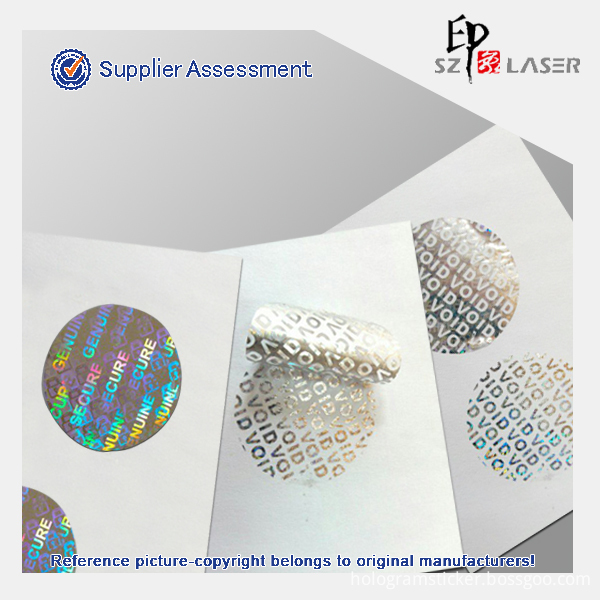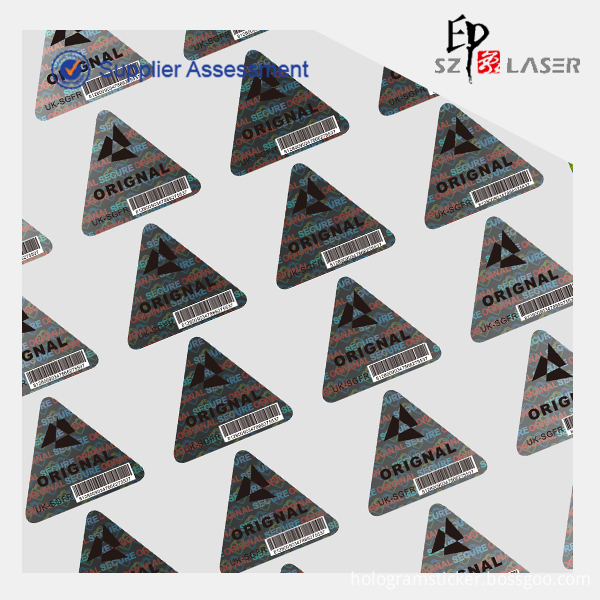Anti-fake colorful Genuine Original Security Hologram Sticker
1. Low MOQ
2.
Custom logo Printing
3. Free cost for hologram master
4. General Patterns like SECURE, ORIGINAL, GENUINE, AUTHENTIC, etc.
Details for Original Hologram Sticker, Secure Hologram Sticker , Genuine Hologram Sticker , authenticity hologram sticker
Genuie Hologram Sticker
Secure Hologram Sticker
If you want to know more details, please contact us!
Internationally recognized principles and methods for the relationship between packaging and the environment are:
4 "R" Principle Reduce: Reduce the use of materials. In ensuring the protection, transportation, storage and sales of packaging, the first consideration is to minimize the total amount of materials used.
Reuse: Use it again. Consider that all or part of the package is used, recycled, treated, and reused.
Recycle: Recycling process. Used packaging is recycled, processed and reprocessed for use in different areas.
Recover: Get new value. For example, the thermal energy of recycled materials is used for incineration.
Starting from common sense, the above arrangement is decremented by the priority program. The vast majority of people have acknowledged the highest priority for reducing the use of materials and reducing the generation of waste. There are different controversies regarding the priorities of the last three items.
Life Cycle Analysis LCA:
Judging and making decisions based on common sense to make environmental issues is often dangerous. Because people generally cannot see the entire life cycle of a product (or service). Only by insisting on examining the total impact on the environment in all aspects of the entire life cycle can the subjectivity and blindness of decision-making be avoided.
According to the definition of the International Organization for Standardization (ISO), life cycle analysis is a method of summarizing and evaluating the potential impact of all inputs and outputs of a product (or service) system on the environment throughout its life cycle.
The International Environmental Toxicology and Chemical Society (SETAC) defines the life cycle analysis method as an objective method for assessing the burden on the environment caused by a product, process, or activity through the identification and quantification of energy, raw material consumption, and waste emissions.
In recent years, the theory of Industrial Ecology has been popular in the world, that is, a sustainable industrial strategy to minimize waste and improve the recycling of materials and energy.
The packaging industry is moving toward a new pattern and companies are going to scale:
In recent years, the trend of globalization of the world economy has become increasingly apparent, and examples of mergers and acquisitions of companies abound, such as: Exxon and Mobil, Mercedes-Benz and Chrysler, Ford and Volvo, Renault and Nissan, AOL and Time Warner. In 1998, the amount of corporate mergers and acquisitions reached US$240 billion, an increase of US$100 billion over 1997. The main purpose of mergers and acquisitions and economic globalization is to compete for greater market share. As a direct result of mergers and acquisitions, the first is to expand the scale and play a greater role in the market; the second is to achieve corporate layoffs and reduce the number of employees.
China's packaging companies have also turned their eyes from local and local markets to foreign and foreign markets, the entire country and even foreign countries. Some coastal packaging companies have started to implement plans for the development of the western region; some packaging companies are rapidly emerging to form larger groups and scales; some have already been deployed in the country.
The thirst for education and talent has become stronger:
The development of increasingly complex packaging technologies, the development of the global market, and the strong growth of the packaging industry are driving the development of packaging education and the development of packaging human resources.
In the United States, more than 10 universities have fully launched education programs that grant bachelor's degrees. Michigan State University is the first university in the world to offer packaging courses and confer a bachelor's degree. It has 50 years of innovation in this field and can now award a doctorate in packaging.
In China, packaging education at all levels has flourished, and more than 20 universities have opened the packaging profession and can award bachelor's degrees. Not only has trained a large number of packaging talent for the country, it has also attracted students from neighboring countries. As the previous establishment of a packaging master's degree granting unit was canceled, it has had a negative impact on the development of China's packaging education. Some students who wish to obtain a higher degree, including international students in China, have to make outsourcing an wise choice:
In a foreign country, when a company produces a certain product and its output cannot be used to fully and reasonably use the investment of existing equipment and related facilities, then the complexity of packaging, the numerous procedures of packaging, and the factors of transportation packaging and secondary packaging are also considered. The operators often entrust the packaging of their products to specialized packaging companies. This common practice abroad should attract the attention of domestic companies.
Need low quality packaging materials:
This is a very important issue in the future. We need better quality and lower cost packaging materials. Plastics have offered solutions for us in many ways. Perhaps the plastic beer bottle is the next packaging product that brings about great changes. The treatment of "white pollution" has led us to look for a variety of alternatives, from plant straws to pulp molding and degradable plastics, all of which are being explored and experimented.
Packaging equipment is still in monopoly:
From a global perspective, it is currently the "big four" of packaging equipment - Germany, the United States, Italy and Japan continue to monopolize the market. In the future, equipment and assembly lines will shift from mechanical control in the past to electronic control. China's domestic high-precision large-scale production lines have been mainly introduced. In recent years, the level of packaging equipment manufacturing has greatly improved, but it requires great efforts to export in large quantities.
Material
Destructible Polyester Material
Thickness
Usually 30micron, based on customer needs.
Size
Stock 30*30mm, 15*15mm, can die-cut according to requirements
Design
Attrative Hologram Generic patterns
Shape
Square, Circle, Oval, Triangle, etc.
Type
adhesive, hot stamping, tamper evident, cold lamination, etc.
Structure
hologram+Pressure Sensitive Adhesive+Silicon Paper.
Combined with other processing
Multi color printing; Serial numbers; QR code; UV ink; HS ink etc.
Sample
Availabel for free
Packaging
PP bag and hologram packaging boxes inside, standard export carton and white packing belt outside.


Generic Pattern Hologram Sticker
Original Hologram Sticker, Genuine Hologram Sticker, Colorful Hologram Sticker, authenticity hologram sticker
Suzhou Image Laser Technology Co., Ltd , http://www.nip-optics.com